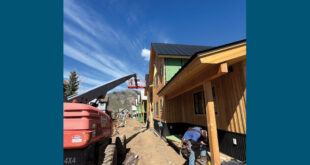Fifty years ago, in the spring and summer of 1962, construction commenced on Blue Mesa Dam—a major part of the Colorado River Storage Project, one of the largest construction projects ever undertaken.
Four Western Colorado water organizations have collaborated on public events for Monday, June 4, to commemorate this anniversary: the Gunnison Basin Roundtable, the Colorado River District (celebrating its own 75th anniversary), the Upper Gunnison River District, and Western State College’s Water Workshop.
The day’s events will begin at 11 a.m. with a “narrated tour” by bus to the base of the 342-foot dam. Many people have seen the dam from the top, where Colorado Highway 92 crosses it, but it is an entirely different experience to see it from the bottom of the canyon, where the power-generation facility is.
Facility manager Ted Dunn of the U.S. Bureau of Reclamation will lead the tour of the dam; historical context on the trip down will be provided by members of the Upper Gunnison River District board and staff, sponsors of the tour.
There is no charge for the tour but reservations are needed; call Bev at the Upper Gunnison office, (970) 641-6065 by Friday, June 1 at 5 p.m. For security reasons, a photo I.D. will be required. The tour will leave from Western’s College Center parking lot at 11 a.m. sharp, and should return to Gunnison by 1:30 or 2 p.m.
The Gunnison Basin Roundtable will hold its regular monthly meeting in the afternoon from 3 to 5 p.m. at the College Center ballroom on the Western State College campus, hosted by the College’s Water Workshop. The roundtable was created in 2005 by the Colorado General Assembly, one of nine roundtables in the state’s numerous river basins. The roundtables were created to “localize” the process of planning for the water needs of the state, anticipated to outgrow current developed supplies by as much as 200 billion gallons by mid-century.
Each roundtable has representatives from local governments, important economic sectors, environmentalists and government agencies as well as the traditional water-supply organizations. The meeting is open for those curious about the organization, with a period for public comment and questions at the end.
The commemoration program will begin with a public reception at 5:30 p.m., also at the College Center, featuring a “birthday cake for the dam,” with coffee and lemonade.
At 6:30 p.m., at the College Center, the Colorado River District will host its annual “State of the River” presentation, being held in Gunnison for the first time, to feature the Blue Mesa commemoration. The Bureau of Reclamation will begin the program with an overview of the water situation for the Gunnison River this year, and what is happening with the reservoirs.
After that, it will be all about Blue Mesa and the Colorado River Storage Project. Local water historian George Sibley will give a brief overview of the Storage Project, and Blue Mesa’s role in it.
Then Vern Jetley of Montrose will give a presentation on the construction of the dam, illustrated with slides he himself took through the construction period in the 1960s as official photographer for the Bureau of Reclamation.
Blue Mesa Dam creates the largest body of water in Colorado, but it is less than half the size of the reservoir the bureau wanted to build. The larger purpose of the Colorado River Storage Project was to store roughly twice the annual flow of the Colorado River in large “holdover” reservoirs, against the dry years (like this year), water that could be released gradually as needed throughout the American Southwest by thousands of food producers, more than 30 million urban dwellers, industries, and now recreational and environmental “users” like rafters, fishermen, and the endangered fish species.
But the 800 billion gallon holdover reservoir the bureau wanted (twice the average annual inflow of the Upper Gunnison tributaries) would have backed water up nearly to the Gunnison city limits—leaving a dusty plain west of town as the water level was drawn down through the summer and fall.
Led by attorney Ed Dutcher and three dozen other community leaders, the people of Gunnison “drew a line” at the 7,520-foot elevation, and applied what political pressure they could to get the proposed reservoir’s maximum water height cut to that elevation (about 150 feet lower than Gunnison’s elevation). It helped, first, that their argument was reasonable, and second, that Gunnison rancher Dan Thornton was governor at the time; they were eventually successful. Blue Mesa—along with Morrow Point and Crystal Dams below it—became instead an important source of electric power, revenues from which continue to help repay the cost of the whole storage project, and also provide funding for the fish recovery program.
For more information about the program of events, call Upper Gunnison manager Frank Kugel at (970) 641-6065, or George Sibley at (970) 641-4340.
Check Also
School board considers affordable housing proposal
Donate property for 20 deed restricted modular homes By Kendra Walker The Gunnison Watershed School …
 The Crested Butte News Serving the Gunnison Valley since 1999
The Crested Butte News Serving the Gunnison Valley since 1999

